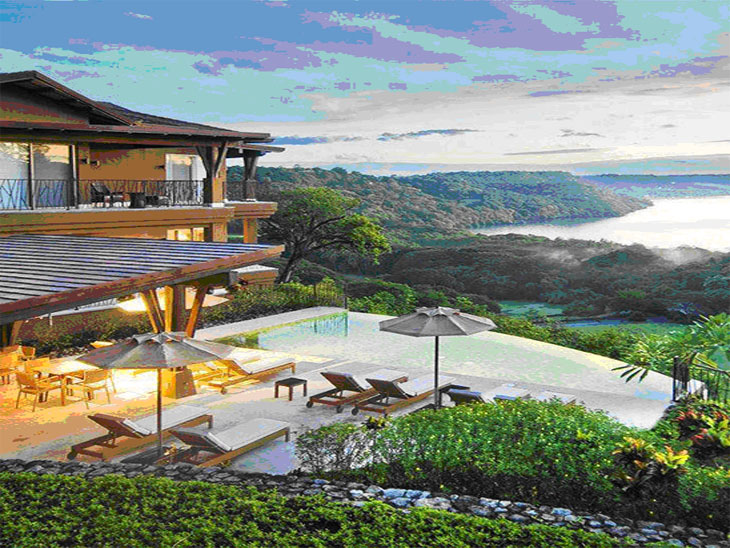|
|---|
How About a Humble Little Cabin in Costa Rica to Escape To On the Weekends? |
Broken News
(All the News That's Fit to Reprint)
Perpetual Tourist Rules Changing
 |
|---|
The 90-Day Visa Stamp |
The standard visa for an American tourist in Costa Rica is a passport-stamp that expires after 90 days.
There is currently no limit on how many times you can renew the 90-day visa by leaving the country at the end of the period, crossing an adjoining border such as Panama or Nicaragua and returning a day or two later (technically it's supposed to be 72 hours but people routinely find a way around this requirement). The rules are always changing and now there is renewed interest by governments in Costa Rica and Panama to tighten the rules concerning so-called perpetual tourists.
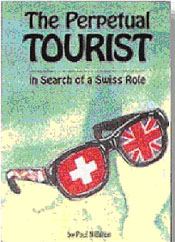 |
|---|
It's Not Just a Costa Rican Problem |
An ex-pat who doesn't have a Cedulá (residency card) can live here indefinitely if they repeatedly renew their visa by crossing the border every 90 days. A person who does this is referred to as a "perpetual tourist" or "PT". But without a cedulá you can't open a bank account, get a driver's license, join the health system or do a number of other important things only on the basis of a visa or passport that would be considered "normal" living . In the past you could get a driver's license with just a passport but now that has been changed. The minute someone asks for your cedulá number for these activities and you don't have one, you're SOL Get caught with an expired passport visa and your subject to deportation, although that's rarely done.
Usually, there are only three reasons why someone becomes a perpetual tourist: (1) the process of obtaining a cedulá takes more that 90 days (usually 6-8 months) which means you're likely to have to play the game at least once (GG had to do it four times before he got his cedulá), (2) the individual can't afford or won't spend the several hundred dollars necessary to get a cedulá, (even more if you choose the wrong person to help you; see Gullible Travels).
The third reason for not getting a cedulá is there is something in the person's history that would disqualify them from getting a cedulá, like a felony or colorful police record. As a friend of mine jokingly puts it: "There are only two reasons people come to Costa Rica, because they're unwanted or because they're wanted". There's a gem of truth there.
If someone is unable to produce the right papers, they become a candidate for deportation (undocumented aliens, who have been discovered. are often sent back, often to Nicaragua). Renewed interest in clamping down on perpetual tourism comes in the wake of a recent deportation of a child molester wanted in the U.S., who somehow also managed to own a house here. This guy had a cedulá (not sure how he got it) but once it was checked against Interpol records, he was apprehended. Knowing the way this government acts, that home of his will become the property of the government without the ability of the accused to challenge it.
So, if you intend to live here at least six months a year, do the right thing and go for the cedulá.
¡Pura Vida!
Cow Patty News
Bulletin! Bulletin! Our RSS feeds from Reuters and AP were humming recently to announce the news that we may have, at least partly, arrived at a solution to emissions of that bad, nasty greenhouse gas, methane.
| Anaerobic Chemical Reduction of Carbon Dioxide to Methane |
|---|
Cows produce methane on both ends and are reputed to be a major source of methane. A redox reaction, as you may remember from high school chemistry (I'm being a smart ass here) removes oxygen from a chemical, usually replacing it with hydrogen. The opposite reaction to redox is, of course, oxidation. The CO2 reaction mentioned requires an anaerobic condition (lack of oxygen). The act of chewing their cud causes a reduction (redox) reaction in an anaerobic state that converts carbon dioxide released from the grass they're chewing into methane. The CO2 present in the cow's droppings also is in an anaerobic state so that a cow patty can be a significant (??) source of methane according to some.
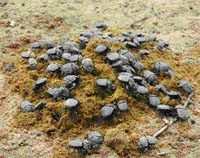 |
|---|
| Our Enviro-Buddy, the Ubiquitous Dung Beetle |
Now comes an exciting research report from Finland about dung beetles and cow patties done at the University of Helsinki. (I wondered what Finnish profs did for excitement - turns out they study excrement for excitement).
It seems the lowly dung beetle can reduce methane emissions from cow droppings by their burrowing and tunneling into the patties they call home. The tunneling provides aeration and oxygen to the patty preventing the anaerobic redox reaction. Quod Erat Demonstrando, less methane results. This is great news for Costa Rica where we have a lot of farms and mucho bovine dung.
What's next for this discovery? Will there be more fecund Finnish forays into the fetid feces of flatulent farm animals? (told you I couldn't resist alliteration) Only time will tell.
Really amigos, I couldn't make this stuff up if I tried.
It isn't only the lowly dung beetle that benefits humankind but also one of our most beautiful creatures, the Morpho butterfly. Their beauty alone would be enough to keep them around but now scientists are telling us they made also provide some amazing physiochemicel properties that could revolutionize some of our technology. Here's part of the report:
 |
"Smart" Nanobiomaterials on the Wing |
"Japanese scientist Eijiro Miyako and colleagues explain that Morpho butterfly wings have natural properties that are beyond the capabilities of any current technology to reproduce artificially. In addition to being lightweight, thin and flexible, the butterfly’s wings absorb solar energy, shed water quickly and are self-cleaning. Miyako’s group had been working with tiny cylinders of carbon termed carbon nanotubes, and became fascinated with the tube's unique electrical, mechanical, thermal and optical properties. Miyako’s team set out to marry the wings and nanotubes to produce an all-new hybrid material.
They describe growing a honeycomb network of carbon nanotubes on morpho butterfly wings, creating a composite material that could be activated with a laser. The resulting material heated up faster than the original components by themselves, exhibited high electrical conductivity and had the ability to copy DNA on its surface without absorbing it
Our present study highlights the important progress that has been made toward the development of smart nanobiomaterials for various applications such as digital diagnosis, soft wearable electronic devices, photosensors, and photovoltaic cells.”
So there you have it. "smart" nanobiomaterials from butterflies. What's next?
Rumble Talk
(Shaky Happenings On or About the Pacific Rim)
Didn't Feel a Thing
There's been an volcanic eruption with an energy release 17,000 times more than ever recorded at Hawaii's Kilauea, the most active volcano on earth. Relax amigos, we didn't feel a thing in Costa Rica. That's because it occurred on one of Jupiter's four major moons, the one closest to the planet, the moon called Io.
 |
|---|
Jupiter With Its Four Major Moons (Io is in Center) |
 |
Close-up of Io Erupting (White Dot Top Left) Taken With GG's Cell Phone
|
Volcano eruptions and quakes result from the same thing, namely geothermal activity caused by the movement of geological plates upon which our continents float over a molten core and upon which we also float. But volcanic behavior occurs in other parts of our solar system, our galaxy and throughout the universe.
Jupiter is our solar system's biggest planet at 318 times the mass of earth. It has a diameter over 11 times that of earth or 142,800 kilometers (about 89,000 miles). Jupiter has one very interesting characteristic; it revolves 2.5 times per earth day. Since it's so much larger that means that someone on the surface is traveling centrifugally at 2.5x89000/24 = 29,125 miles per hour compared to about 1,000 miles per hour on earth. Even correcting for Jupiter's higher gravity (2.64 that of earth), the adjusted centrifugal speed is about 11,000 miles per hour. If we visit Jupiter, guess we had better take our magnetic boots so we're not thrown off towards Pluto.
The moon Io is believed to be the most active place for volcanic activity in the solar system. It is the third largest of the main moons and is roughly equal in diameter to Earth's moon. Io has many faults that spew out molten sulphur on a regular basis. The eruption that occurred recently (photo right) was 100 to 500 times bigger than any ever recorded on earth. In an area named after the Czech fire god Rarog Patera, material was spewed out some 200 miles into space. The area is not known to be particularly active with volcanoes, but is believed to have fountains of lava streaming from fissures on Io’s surface.
Yet there were no reports of locals here feeling the eruption, That may have something to do with the fact that Io is some 628,300,000 kilometers (393,000,000 miles) away from Earth.
C'mon amigos, the section header does say "Shaky Happenings On or About the Pacific Rim".
¡Pura Vida!
| Check Out Recent Earthquakes Around the World Posted by the U.S. Geodetic Survey: Today's Quakes |
|---|
History of Costa Rica - A Primer, Part II
(The Spanish Occupation, from 1502 to 1821)
This continues the story begun last month: History of Costa Rica - A Primer, Part I. (The Pre-Columbian Period). So now we move on to the Columbian period.
It was 511 years ago, on September 18, 1502, when Christopher Columbus dropped anchor off Limon on the caribbean side of Costa Rica in the middle of his fourth and last voyage to the new world.
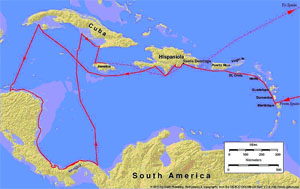 |
|---|
Columbus' Fourth Voyage |
This swan song voyage lasted over two years, as Señor Colón anchored his six ships in several ports in the caribbean islands where Spanish colonies had been established in the ten years after his first voyage. Chris went on to explore the Central American caribbean coast starting in the north at Honduras and eventually ending up in Almirante Bay in Panama (near Bocas del Toro). He stopped for some time in Costa Rica and noted how friendly the natives were (they still are).
At the end of this voyage Columbus would end up being dragged back to Spain in chains after making enemies of the various territorial governors of the islands who conspired against him. They objected to Chris' demand of the Spanish Crown that he be given deed to all the lands in the new world he discovered and would discover (Chris dude, slow down, a little more flexibility and generosity might have prevented the chains amigo). Eventually he would be cleared of all charges and die a rich man although not nearly as rich as he had hoped to be. His children would continue the fight for new world ownership rights in the courts and at the Court, to no avail.
Reportedly, the indigenous people Columbus met on the Costa Rican caribbean coast showed him some Tico friendliness by rowing out in their canoes to greet and welcome him. One of Columbus' lieutenants noticed a great deal of gold earrings, studs and ornaments dangling from the indians bodies (the Ticos were in their Sunday best) and Columbus, perhaps stealing the idea from his lieutenant, coined the name for the area as Costa Rica or the Rich Coast (and I bet you thought it was named for the lush jungle foliage). Little did the natives know that the arrival of the Spanish would change their lives forever and end up obliterating many of their tribes and almost obliterating the rest of them.
 |
|---|
Ay, Matey! |
Of course, once the other monarchies in Europe got wind of what the Spanish were doing in the new world, the waters of the caribbean began to see ships plying its waters under many other flags, particularly, English, French, Dutch and Portuguese. The era of European colonization in the new world had begun. Skirmishes, wars and acts of piracy (many by French and English privateers) would become commonplace and last for several centuries.
Over the 20 years following Columbus' last voyage, the Spanish sent many pseudo-military types, the "conquistadors", under promise of gaining untold riches of gold and precious stones, to secure the land for Spain and to pillage whatever treasurer they came across. Of course, the Spanish Crown would get a substantial cut of the loot and be the biggest beneficiary of this robbery. The "gold fleets" first started in Columbus' time and records show that while Columbus was docked in Jamaica during his last voyage, a fleet of 17 ships laden with treasure sailed from that island right into a massive hurricane losing all but one of the ships. (Sailors and looters should watch the weather reports amigos)
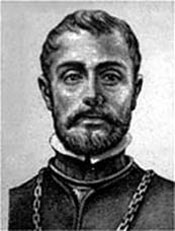 |
|---|
Ponce de Leon - Discoverer of "La Florida" Quite the Rake eh? |
The 1500's saw explosive growth for the Spanish in the new world. The governor of Puerto Rico, Ponce de Leon, who had been on Columbus' second voyage to the new world, explored and discovered "La Florida", landing at St. Augustine in 1513 and claiming it for Spain. That settlement would later be incorporated as a city in 1565 long before Jamestown, VA (1607) and Plymouth Rock, MA (1620).
GG had an amusing experience with regard to that particular colonial history some 35 years ago when vacationing with his family on the east coast of the U.S. We stopped first in Jamestown, Virginia to see "the first settlement in the new world" (meaning the first European settlement - but what they really meant was the first English settlement). "It was in 1607" says the guide. We went on to see relatives in Massachusetts and stopped at Plymouth Rock where we were told by a stern lady in Puritan garb that Plymouth was "The fuhst pahmuhnant settlemunt in the New World - 1620".
GG of course doesn't know when to let things pass and said "Excuse me ma'am, but we were just in Jamestown where they claimed 1607", "Didn't laahst" says she. Evidently the Jamestown settlement died out for a few years and was re-established later. When GG moved to Florida and visited St, Augustine, I laughed about the northeast coast people and their adamant claims, when in fact St. Augustine was the first permanent European settlement in what is now the United States and it was at least half a century earlier than Jamestown or Plymouth Rock.
 |
|---|
1st Governor of Costa Rica Would You Buy a Used Galleon from This Dude? |
In the early sixteenth century the Spanish grip on the Americas was growing and tightening fast. By 1521 Spain had set up Viceroyalties in Mexico (then called New Spain) to govern that country and most of Central America. A second viceroyalty was set up in Cartagena, Columbia to govern South America. Panama was relegated to the Cartagena Viceroyalty. The Viceroyalties were further divided into "Captaincies" so that Costa Rica became the southern most province of the Viceroyalty of New Spain reporting to the Captaincy of Guatemala.
The first governor of Costa Rica was Francisco Vázquez de Coronado y Luján, a Spanish nobleman who came from the central mountains of Spain, having been born in Salamanca. He arrived in Mexico in 1535 at the age of 25. Francisco was first appointed governor of a large portion of northwest Mexico where he heard rumors from explorers that there were seven golden cities to the north.
So Coronado convinced his buddy Antonio de Mendoza, the Viceroy of New Spain at the time to join with him in financing a major expedition northward, led by Coronado. The city of Cibola, Arizona, reportedly one the seven cities of gold, was their principal target. Coronado was greatly disappointed not to find any gold in Cibola and pushed further northward and northeastward, finally reaching parts of what is now Kansas (no obvious gold there either, Dorothy). Along the way Coronado was the first European to discover a big hole in the ground, now called the Grand Canyon. After spending more than two years and a lot of his personal fortune, Coronado returned to Central America empty handed, lowered his expectations and later became governor of Costa Rica.
Reportedly, Coronado was much more diplomatic in his dealings with the natives here than the typical conquistador was in other provinces. The country also benefited from benign neglect by the New Spain Viceroyalty for two reasons: Costa Rica was viewed as rough and difficult to traverse because of its jungles and mountains and also because no gold or silver had been found here. So Costa Rica was largely spared the heavy hand of the conquistadors although the indigenous population was eventually decimated by the 300 year Spanish occupation nevertheless. A lot of that had to do with the over-zealousness of the priests the conquistadors brought along with them. In the tradition of Columbus, Coronado was later accused of several crimes of "avarice" and mismanagement but also like Columbus he was eventually cleared of all charges. Coronado died in 1554 at the age of 44 during a shipwreck in the caribbean.
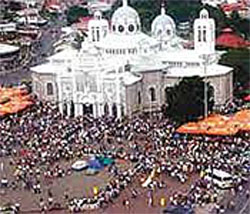 |
|---|
| Cartago During "La Negrita |
The Spanish established their first military garrison in Costa Rica at what is now called "La Garita", which is west of modern San José. You can still see the ruins of the fort by driving along the mountain road east of Atenas. In 1560, the first permanent Spanish community was established in Cartago, about 20 kilometers as the toucan flies southwest of San Jose. Cartago would later become the first capital city of independent Costa Rica.
Cartago was also the site of the first church built by the missionaries along the Rio Reventazón and later, and still is today, the site of a cathedral important in the Costa Rican culture. This basilica is the focal point of an annual walking pilgrimage (La Negrita) of between one and two million people from all over Costa Rica and neighboring countries.
During the 300-year long Spanish colonial era in Costa Rica the country would have as many as 70 Spanish governors. These were a mixture of political appointees, conquistadors and other adventurers. During this time the Spanish language and culture would overwhelm the natives and Costa Rica became a truly "latino" culture. There was even a period of 50-60 years where the Spanish crown granted colonials the right to enslave the indigenous population to serve as workers. Other slaves were imported from the caribbean to also work the farms and plantations. The practice of slavery in the Spanish colonies would die out in the mid-eighteenth century, a hundred years before the Emancipation Proclamation in the United States.
By 1821 the various colonial provinces in the confederation had had enough of Spanish hegemony and the Spanish governments in Mexico and Guatemala were overthrown, ushering in independence and the modern era for Costa Rica. The New Spain colony revolt was encouraged by Simon Bolivar's successes in liberating South America. (SB's real name was Simón José Antonio de la Santísima Trinidad Bolívar y Palacios Ponte y Blanco (whew, I bet his friends just called him Joey)
The era of Spanish colonization of the Americas was finally over. So now, what would Costa Rica become???
Next month: History of Costa Rica - A Primer, Part III (The Modern Era, 1821 to Present)
¡Pura Vida!
The Peculiar Pejibaye
(The Fruit of the Peach Palm)
My guess is that at some point during the Spanish occupation the conquistadors or one of their underlings must have seen the natives gathering clusters of a strange reddish-orange fruit from high in a palm tree.
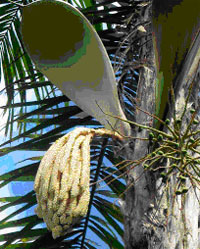 |
|---|
| Peach Palm Flower |
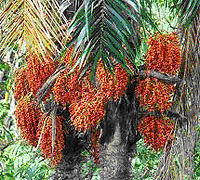 |
Pejibaye on the Tree |
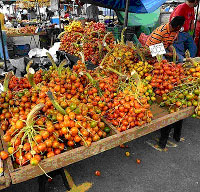 |
... and at the Feria |
The palm tree the fruit comes from is called a Peach Palm but there are no peaches. The "fruit", which is more like a squash than a fruit, is called pejibaye (pay-hee-buy-yay). They usually grow in large clusters of 50 to 100 fruit. The clusters are self-protected from animals by long, sharp thorns that can be dangerous to animal raiders as well as to a person harvesting the fruit.. Pejibaye are routinely available at our local Feria (farmer's market), at roadside stands and even in supermarkets (thorns removed of course).
The Peach Palm produces fruit twice a year first by opening a hugh, clam shaped flower and exposing a number of strings on which white seeds hang. The seeds attract swarms of black bees that devour an outer layer of the seeds. This allows the seeds to be easily pushed out by the budding flower causing a shower of white to hit the ground indicating the palm is fruiting. Later, when the large leaf drops to the ground, the fruit begins turning orange and red and the dropped leaf signals that the fruit is ready or nearly ready to harvest.
Unlike mangoes, oranges, papaya and pineapples you just can't pull pejibaye off the plant and start eating; they require considerable preparation. (This is where the sloth in me comes out and I look for others to do the dirty work; I have the same feeling towards crabmeat). You start the pejibaye preparation process by slowly boiling the fruit in heavily salted water for one to two hours. Vendors who sell the fruit by the piece often leave them in the hot water afterwards to keep them warm for the customer.
 |
|---|
Preparing Boiled Pejibaye |
The fruit is then cut into halves and the large peach stone-like nut in the center is removed. The fruit is then easy to peel which is necessary as the peel is bitter and rubbery. Or it may ben eaten like an orange half.
After peeling, chef creativity takes over. There are recipes for cream of pejibaye soup, for a mixture of it with cornmeal, eggs and milk to make a stuffing for roasted fowl, as well as concoctions for cakes and cookies and even one to make it into a jam. As with most fruits it can also be combined with sugar and, over a number of days. it will ferment into an alcoholic drink (hic). But Ticos favor the simple life. Many just take a boiled, peeled (or unpeeled), denutted half, apply a dollop of mayonnaise or cheese spread and gobble it down neat or with a cup of coffee.
Like many tropical fruits, pejibaye is very nutritious, being rich in Vitamin C, calcium and phosphorous. But one cautionary note is indicated in the literature and that is that the fruit is high in calories. A 100 gram serving (about 3.5 ounces or slightly less than a quarter pound) contains 1,095 calories. On the McHappy Index that's 2.0 times a Big Mac and compares to only 48 calories in the same amount of pineapple and 65 in 100 grams of mango.
So, please partake of prepared pejibaye but pause to ponder the possible payoff to your paunch. (Sorry, I can't resist these things - it's a congenital defect)
¡Solo Bueno!
Hanging Around
(In Defense of Slothful Behavior)
Just about everybody knows that sloths, after which the character defect is named, are the slowest moving mammals on the planet. But I had never seen a sloth in the wild until my first trip to Costa Rica in 2003.
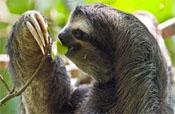 |
|---|
Look Ma, I've Got Three Toes |
 |
The Sloth's Favorite Tree The Guarumo |
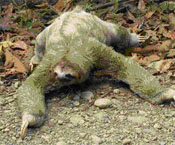 |
|---|
Two-Toed Sloth |
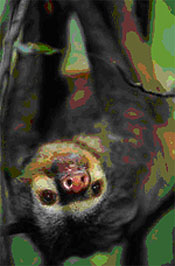 |
Wazzup Amigo? (Everything) |
Scientists report there are a total of five different species of sloth in Costa Rica but they are basically divided into two major types, the two-toed and three-toed sloths. They are both forest foragers and primarily herbivores that concentrate on leaves but also spice up their diet with shoots, fruits, nuts, berries, bark, some native flowers, and even some small rodents. The leaves of the Guarumo tree is their favorite food.
The three-toed sloth has long coarse hair over dense under fur, a white face with a brown stripe on each side, a brown throat, and a body that is pale brown to yellowish. For the two-toed version, coloration of body hair in adults is a mosaic of tan, blonde, and light brown.
Scientists say these two types (both of which have three toes on the back feet) may inhabit the same forests but they are not closely related, They are believed to have developed separately over the millennia, both probably having evolved from ground dwelling sloths which are now extinct. The differences that resulted from their parallel but separate histories include the fact that the two-toed version is bigger, stronger, can be more aggressive if threatened and primarily is nocturnal, sleeping during the day. The three-toed sloth.on the other hand is smaller, active during the day and tends to be less aggressive. It is also the (really) slower moving of the two.
Sloths often have algae growing on their fur which gives them a green cast that provides additional camouflage in the canopy. This is especially true during the wet rainy season. They also can have several arthropods (spiders, ticks, beetles) housed in their fur, so it's not a great idea for the unknowing person to pet these animals for this reason and also because they might get aggressive if they think they're being threatened. The opportunity to do so is limited anyway because sloths spend nearly their entire lives in trees
The digestive system of a sloth includes a multi-chambered stomach which can expand to 30 times it's normal size to house all the leaves, berries etc. that they consume. The digestion is extremely slow and may take up to one month to complete the process. This fact supports one of the strangest habits they have, namely descending to the ground only about once per week to go to the bathroom. They dig a hole, do their business and scratch leaves over their deposit much like a dog. During this thirty minute process they become most vulnerable to their most common natural predators, the Wild Cats of Costa Rica.
Sloths' slow metabolism and inability to move quickly (like about a tenth of a mile per hour) is thought by some to be a result of their limited diet; by others to perhaps reflect the effect of narcotic-like ingredients in some of the particular leaves they eat. I'll go for the latter reason because there are other creatures in the jungle that live off leaves, although from smaller plants, and have high energy levels and strength, such as leaf-cutter ants (see Busy Zompopas). Also, anything that can hang around upside down for hours has got to be a little high (I had some fraternity brothers in college that were like that).
 |
|---|
What's Not to Smile About Amigos? |
One of the characteristics a sloth exhibits is that they seem to be smiling continuously. Maybe they have it right, shut-off the cell phones, the iPads and all the rest and just enjoy the jungle. They don't deserve the negative connotation their name conjures up.
I for one won't be the first to throw a coconut at a sloth as GG can often be found in a reduced state of metabolic activity perched on top of a wooden chair at the beach with a canopy overhead, much like the sloth.
Tranquilo amigo, tranquilo.
¡Tuanis, Mae!
What's-in-a-Word
Perezoso
Spanish for Sloth. Also an adjective meaning lazy, slow or sluggish. When referring to a person, it's a noun (perezoso = male; perezosa = female):
Milagro
Miracle, as in Miracle Cafe (Cafe Milagro). For an interesting story on how miracles pop up in everyday life, go here: Madness and Miracles.
ROMEO Corner
(Retired Old Men Eating Out)
Cafe Milagro (Manuel Antonio)
Location: Top of the hill, across the street from the bus stop near the Mariposa Hotel
Hours: Breakfast, Lunch and Dinner
Parking: Limited in front and on the road.
Contact: Tel.: Tel. 2777-0794/2777-2272; Email: N/A; Website: http://www.cafemilagro.com/contact/
Reviewing ROMEOS: Brian M., Ted P., Jim M., Bob N.
To Review Our Rating System and Procedure, go here: R.O.M.E.O. Rating System
 |
Cafe Milagro or Miracle Cafe has two locations, one in downtown Quepos on front street near the bay and the other at the top of Manuel Antonio hill. At the time of this writing, the downtown location was in the process of closing and had eliminated dinner from their offering but the MA location still offers full day service. The Quepos location is closing in favor of reopening in a new location a half kilometer to the south at the new marina. Target opening: 1 December, 2013.
The back of their menu tells the story of how Cafe Milagro came about and why it's a miracle. Founded by a couple of college kids now in their thirties, it was a simple coffee shop they started after graduating. Then, somewhere along the line they found an old Tico coffee roaster which they got from an old Tico (couldn't resist) for a small investment. GG has always enjoyed their products, particularly the dark and espresso roasts, and has shipped a number of bags to the U.S. as gifts over the years. You can order online through their website (link above).
The MA restaurant is located on the busy main road to Manuel Antonio beach and National Park. There are three distinct dining areas, a number of tables near the road, some tables inside the main building and a garden area in the rear. The garden was closed the evening we were there. The atmosphere is pleasant, a little dark (GG and his cataracts had a difficult time reading the small-font, script print in the subdued lighting) and the tables and chairs are simple and plain. We give the restaurant 3 1/2 sloths for atmosphere.
GG preceeded the main course with a simple dish of a chilled avocado soup. Tasty and refreshing. The menu had a considerable offering of meats and seafood done with a customized flair. GG had a lomito (filet) of pork that had been sliced and mounded over a mixture of what appeared to be small cubes of yucca and squash. The seasoning was somewhat Caribbean and delicious. Another ROMEO had a lomito of beef with a coffee-based sauce (GG had that in the past and it's truly unique and delicious). Yet another ROMEO a dish of shrimp and vegetables seasoned with a "tropical" mixture. The dessert menu was a bit limited but a brownie with ice cream (a stereotypical regional offering) sufficed for two of us. Overall, we gave Cafe Milagro a 4 1/2 sloth rating for food quality. |
 |
|---|---|
$$$$ 1/2 |
|
Value Index = |
Our server was attentive and helpful and one of the owners (Lance) was aware enough to ask if we were enjoying our meal (GG doesn't take this lightly as asking how the meal is going is a distinctly gringo thing). We give Cafe Milagro 4 sloths for service.
As usual, GG had a larger bill than the other ROMEOS which, for soup, pork lomito, brownie and two cokes came to 12,500 colones ($25). By itself that would be quite good but we hit the restaurant on a night when the dinner menu was 50% off. Adjusting for this and assuming the cokes and brownie were not on the discount that evening,the regular fare would have been something over 20,000 colones ($40). That puts Cafe Milagro in the top 10% of restaurants in the area on a cost basis and we give it 4 1/2 $ on pricing.
All in all the ROMEOS had a very pleasant evening at Cafe Milagro and we're looking forward to reviewing the new restaurant when it opens at the marina.
don Beto de Quepos,
El Gringo Dorado Pura Vida! |
Be pithy but kind. I'm sensitive. |
|---|

